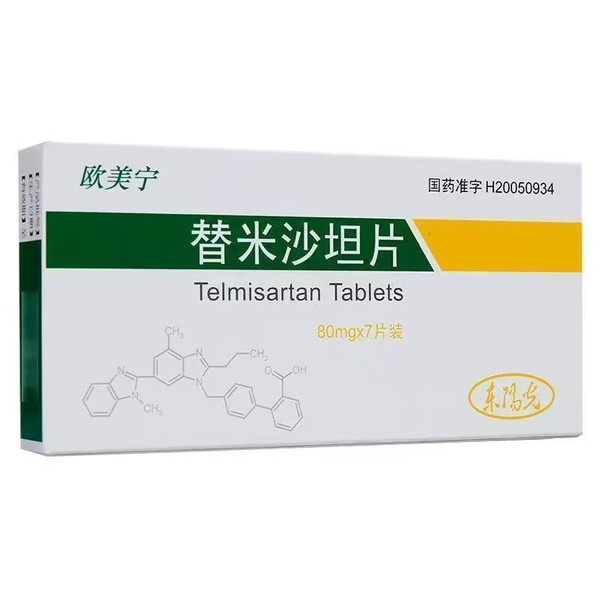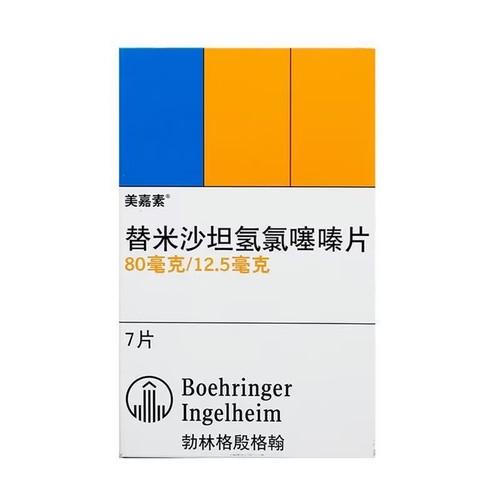Product Overview
[Drug Name]
Generic Name: Telmisartan Tablets
Trade Name: OuMeiNing Telmisartan Tablets 80mg*7 Tablets
Pinyin Code: TiMiShaTanPian (OuMeiNing)
[Main Ingredient]
Telmisartan.
[Appearance]
This product is a white or slightly yellowish oval tablet.
[Indications/Main Functions]
For the treatment of essential hypertension in adults. Reduces cardiovascular risk. This product is indicated for patients aged 55 years and older who are at high risk for major cardiovascular events and cannot receive angiotensin-converting enzyme (ACE) inhibitor therapy to reduce their risk of myocardial infarction, stroke, or death from cardiovascular disease. High risk for cardiovascular events includes a history of coronary artery disease, peripheral arterial disease, stroke, transient ischemic attack, or high-risk type 2 diabetes (insulin-dependent or non-insulin-dependent) with evidence of end-organ damage. Telmisartan can also be used concomitantly with other necessary treatments (e.g., antihypertensive medications, antiplatelet agents, or lipid-lowering drugs). Concomitant use of telmisartan with ACE inhibitors is not recommended.
[Precautions]
In placebo-controlled trials, the overall incidence of adverse events was similar for telmisartan (41.4%) and placebo (43.9%). The incidence of adverse events was not dose-related or associated with gender, age, or race. The adverse reactions listed below are cumulatively reported in 5,788 hypertensive patients treated with telmisartan in clinical trials. Adverse reactions are classified by frequency as follows: Very common (>1/10); Common (>1/100, <1/10); Uncommon (>1/1000, <1/100); Rare (>1/10000, <1/1000); Very rare (<1/10000) Systemic reactions: Common: back pain (such as sciatica), chest pain, flu-like symptoms, symptoms of infection (such as urinary tract infection including cystitis) Rare: abnormal vision, sweating Central and peripheral nervous system: Common: dizziness Gastrointestinal system: Common: abdominal pain, diarrhea, indigestion, gastrointestinal dysfunction Rare: dry mouth, flatulence Musculoskeletal system: Common: joint pain, leg cramps or leg pain, myalgia Rare: tenosynovitis-like symptoms Psychiatric system: Rare: anxiety Respiratory system: Common: upper respiratory tract infection including pharyngitis and rhinitis Skin and appendages: Common: skin abnormalities such as eczema Since the launch of telmisartan, isolated case reports have included erythema, pruritus, syncope, insomnia, depression, gastric discomfort, vomiting, hypotension, bradycardia, tachycardia, dyspnea, eosinophilia, thrombocytopenia, weakness, and decreased work efficiency. Similar to other angiotensin II antagonists, rare cases have reported angioedema, urticaria, and other related adverse reactions. Laboratory findings: Compared with placebo, decreases in hemoglobin or increases in uric acid were occasionally observed in the telmisartan treatment group. Elevations in blood creatinine or liver enzymes were similar to or lower than those observed with placebo.
[Drug Interactions]
1. Hypersensitivity to the active ingredient or any of the excipients of this product. 2. Women in the second and third trimesters of pregnancy and breastfeeding. 3. Patients with biliary obstructive disease. 4. Patients with severe hepatic impairment.
[Pediatric Use]
Due to the lack of safety and efficacy data, this product is not recommended for use in children under 18 years of age.
[Use in Elderly Patients]
No dose adjustment is required for elderly patients.
[Use in Pregnant and Lactating Women]
There are insufficient data on the use of Micardis in pregnant women. Animal studies have shown reproductive toxicity (see Preclinical Safety Data), and the potential risk to humans is unknown. Animal studies did not demonstrate teratogenicity, but fetotoxicity was observed. Therefore, as a precautionary measure, telmisartan should not be used during the first trimester of pregnancy. When planning pregnancy, consider an appropriate alternative treatment. Telmisartan is contraindicated in the second and third trimesters of pregnancy because drugs that directly act on the renin-angiotensin system can damage the developing fetus or even cause fetal death. Discontinue use of this product as soon as possible upon discovery of pregnancy. It is unknown whether telmisartan is excreted in breast milk, so this product is contraindicated in lactating women.
[Specifications]
80mg x 7 tablets (Oumenin)
[Dosage and Administration]
This product can be taken with or after meals. For the treatment of essential hypertension: Dosing should be individualized. The usual initial dose is 40 mg once daily. Telmisartan's antihypertensive efficacy is dose-dependent within the 20-80 mg range. If optimal blood pressure is not achieved after treatment, the dose can be increased to a maximum of 80 mg once daily. This product can be used in combination with thiazide diuretics, such as hydrochlorothiazide, which have a synergistic antihypertensive effect. Because telmisartan typically takes four to eight weeks to achieve its maximum antihypertensive effect after initiating treatment, this consideration should be taken into account when increasing the dose. For cardiovascular risk reduction: The recommended dose is once daily. Whether doses below 80 mg of telmisartan effectively reduce the risk of cardiovascular morbidity and mortality is currently unknown. When initiating telmisartan therapy for cardiovascular risk reduction, close blood pressure monitoring is recommended, and antihypertensive medications should be adjusted as necessary.
[Adverse Reactions]
In placebo-controlled trials, the overall incidence of adverse events was similar for telmisartan (41.4%) and placebo (43.9%). The occurrence of adverse events was not dose-related and was unrelated to the patient's gender, age, or race. The adverse reactions listed below were cumulatively reported in 5,788 hypertensive patients treated with telmisartan in clinical trials. Adverse reactions are categorized by frequency as follows: very common (>1/10); common (>1/100, <1/10); uncommon (>1/1000, <1/100); rare (>1/10000, <1/1000); and very rare (<1/10000). Within each frequency group, adverse reactions are listed in descending order of severity. Infections Common: symptoms of infection (e.g. urinary tract infections, including cystitis), upper respiratory tract infections including pharyngitis and sinusitis Nervous system: Uncommon: anxiety Eyes: Uncommon: abnormal vision Ear and vestibular function: Uncommon: dizziness Gastrointestinal: Common: abdominal pain, diarrhea, indigestion Uncommon: dry mouth, flatulence Rare: stomach discomfort Skin and subcutaneous tissue: Common: eczema-like skin lesions Uncommon: excessive sweating Musculoskeletal system: Common: arthritis, back pain (e.g. sciatica), leg cramps or leg pain, myalgia Uncommon: tendonitis Systemic reactions and application site: Common: chest pain, flu-like symptoms. In addition, since the marketing of telmisartan, there have been rare case reports of erythema, pruritus, syncope, insomnia, depression, gastric discomfort, vomiting, hypotension (including orthostatic hypotension), bradycardia, tachycardia, abnormal liver function, liver disease, renal impairment including acute renal failure (see [Precautions]), hyperkalemia, dyspnea, anemia, eosinophilia, thrombocytopenia, asthenia, and lack of efficacy. The frequency of these events is unknown. Angioedema, urticaria, and other related cases have been reported as events independent of other angiotensin II receptor antagonists.
Contraindications
1. Hypersensitivity to the active ingredient or any of the excipients of this product. 2. Women in the second and third trimesters of pregnancy and lactating women. 3. Patients with biliary obstructive disease. 4. Patients with severe hepatic impairment.
[Overdose]
No cases of overdose have been reported. The most likely manifestations of telmisartan overdose are hypotension and tachycardia; bradycardia may also occur. Telmisartan cannot be eliminated by hemodialysis. In the event of an overdose, the patient should be closely observed and symptomatic and supportive care should be provided. Treatment should be tailored to the timing of ingestion and the severity of symptoms. Recommended measures include inducing vomiting and/or gastric lavage. Activated charcoal may be effective in treating overdose. Serum electrolytes and creatinine should be closely monitored. If orthostatic hypotension occurs, the patient should be placed supine and salt and fluid intake should be promptly replaced.
[Pharmacology and Toxicology]
Telmisartan is an orally active, specific angiotensin II receptor (AT1) antagonist. Telmisartan dissociates angiotensin II, which has a high affinity for the AT1 receptor, from its binding site. Telmisartan does not exhibit partial AT1 receptor agonism. It selectively binds to the AT1 receptor with a prolonged action, while having no affinity for AT2 and other AT receptor subtypes, the functions of which are currently unknown. Telmisartan may increase angiotensin II levels, but the effects of overactivation of AT2 and other AT receptor subtypes by angiotensin II remain unclear. Telmisartan lowers aldosterone levels. It does not inhibit human plasma renin activity or block ion channels, nor does it inhibit angiotensin-converting enzyme (ACE, kininase II), which degrades bradykinin. Therefore, telmisartan does not potentiate bradykinin-mediated adverse reactions. In male patients, administration of 80 mg of telmisartan almost completely inhibited the angiotensin II-induced blood pressure increase. The inhibitory effect persisted for 24 hours and was measurable up to 48 hours.
Pharmacokinetics
Absorption: Telmisartan is rapidly absorbed, although the amount absorbed varies, with a mean absolute bioavailability of approximately 50%. When telmisartan is taken with food, the area under the plasma concentration curve (AUC) decreases by approximately 6% (40 mg dose) to 19% (160 mg dose). Telmisartan plasma concentrations are similar 3 hours after administration in the fasting or fed state. This slight decrease in AUC does not result in reduced efficacy. There is a nonlinear relationship between dose and plasma concentration. At doses above 40 mg, the Cmax increases disproportionately with a small increase in AUC. Telmisartan plasma concentrations vary by gender, with Cmax and AUC approximately 2-fold and 3-fold higher in women than in men, respectively. Distribution: Telmisartan is largely bound to plasma proteins (>99.5%), primarily albumin and α-acid glycoprotein. Its mean steady-state apparent volume of distribution (Vdss) is approximately 500 L. Metabolism: Telmisartan is metabolized by conjugation to glucuronides, which are pharmacologically inactive. Elimination: Telmisartan plasma concentrations decline biexponentially, with a terminal elimination half-life exceeding 20 hours. The maximum plasma concentration (Cmax) of telmisartan increases disproportionately with increasing dose, within a narrow range of the plasma concentration-time curve (AUC). No clinically relevant drug accumulation has been observed with recommended doses of telmisartan. Plasma concentrations are higher in women than in men, but this does not affect efficacy. Following oral (and intravenous) administration, telmisartan is excreted almost entirely unchanged in the feces, with cumulative urinary excretion accounting for less than 1% of the dose. Total plasma clearance (Cltot, 1000 ml/min) is consistently maintained at a high ratio to normal hepatic blood flow (1500 ml/min).









